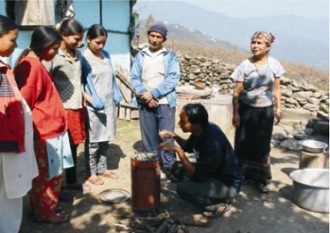The wood is burnt for cooking and brick making or used for fence production. Today more than eighty percent of the scrubland in Caatinga, an ecologically rich and sensitive area within the Ceara region boasts a biome comprised of trees and bushes up to seven metres in height, has disappeared. However, what remains is still home to around 932 types of plants, 148 types of mammals, 510 bird species and countless insects and other creatures. Unlike the rainforest, Caatinga’s climate is semi-arid and subject to long lasting droughts and a short, but intense rainy season.
Yet until a year or two ago, most Brazilians were unaware of Caatinga’s plight. But then two things happened. The federal government’s new environment minister, Carlos Minc, drew attention to the deforestation spreading more rapidly than that of the Amazon, and announced plans for its conservation and recovery. Some time previous to that, a campaign to abolish the toxic, antiquated cooking habits of Caatinga villagers hit the national news.
Using the power of television, for the first time people all over Brazil heard about efficient cook stove technologies which drastically cut the use of wood as a fuel. Something clicked in the consciousness of Brazilians, as better ovens in the home meant less wood consumption, which in turn spares thousands of trees.
Enter four key players in a story that has blossomed from a small pilot of 20 stoves to a sweeping reform affecting thousands. IDER – Brazil’s Institute for Sustainable Development and Renewable Energy – is the NGO that initiated the program. The Global Village Energy Project (GVEP) is the London based organisation that funded the initial pilot project. The Renewable Energy and Energy Efficiency Partnership (REEEP), an international partnership focused on policies, regulations and financial mechanisms in support of clean energy, provided the cash for the project’s second phase, funding its development to a further 200 stoves. Last but not least is Joaquim Cartaxo, Ceara’s State Secretary for urban and rural development. Cartaxo’s involvement has ensured that, a couple years after the pilot, another 4,000 stoves have been paid for by the state’s government, with investment in a further 18,000 currently under construction. The total funding amounts to over US$4.5 million.
Why did this project succeed, when so many others grind to a halt? One reason is that IDER found a major ally in Cartaxo, a politician who immediately saw the benefits of the cook stoves and took action. Dangerous smoke from basic wood stoves used in many developing countries can cost lives and many people have developed serious lung diseases as a result. Hospitals have to treat villagers for respiratory illnesses and eye infections, which costs public money. Studies from the World Health Organisation say that worldwide two million people per year die from indoor pollution caused by inefficient cook stoves.
By installing efficient cooking stoves, hundreds of thousands of dollars may be saved. Not only will people’s health improve as the project workers scrap the ashen slabs bearing their iron pots perched on rickety props, but local businesses will benefit. The new Brazilian stoves consist of a metallic hob and oven frame surrounded by a case of new brickwork that is laid on site. IDER and their colleagues aim to roll out the mass production of the metallic component while providing income for local masons. The homes that will benefit are occupied by families generally in the poorest section of the populace that are unable to afford this type of equipment themselves.



